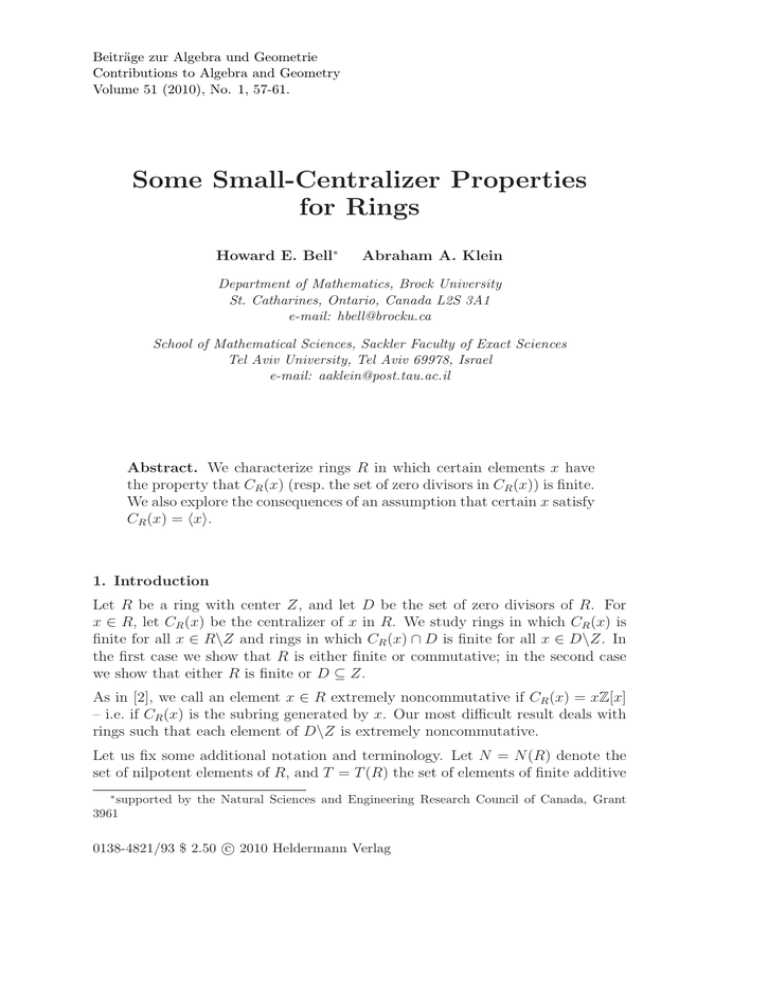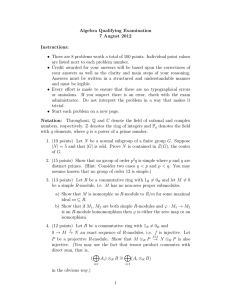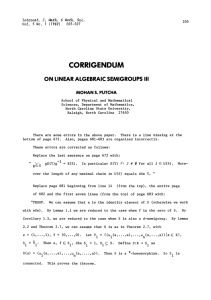Beitr¨ age zur Algebra und Geometrie Contributions to Algebra and Geometry
advertisement

Beiträge zur Algebra und Geometrie
Contributions to Algebra and Geometry
Volume 51 (2010), No. 1, 57-61.
Some Small-Centralizer Properties
for Rings
Howard E. Bell∗
Abraham A. Klein
Department of Mathematics, Brock University
St. Catharines, Ontario, Canada L2S 3A1
e-mail: hbell@brocku.ca
School of Mathematical Sciences, Sackler Faculty of Exact Sciences
Tel Aviv University, Tel Aviv 69978, Israel
e-mail: aaklein@post.tau.ac.il
Abstract. We characterize rings R in which certain elements x have
the property that CR (x) (resp. the set of zero divisors in CR (x)) is finite.
We also explore the consequences of an assumption that certain x satisfy
CR (x) = hxi.
1. Introduction
Let R be a ring with center Z, and let D be the set of zero divisors of R. For
x ∈ R, let CR (x) be the centralizer of x in R. We study rings in which CR (x) is
finite for all x ∈ R\Z and rings in which CR (x) ∩ D is finite for all x ∈ D\Z. In
the first case we show that R is either finite or commutative; in the second case
we show that either R is finite or D ⊆ Z.
As in [2], we call an element x ∈ R extremely noncommutative if CR (x) = xZ[x]
– i.e. if CR (x) is the subring generated by x. Our most difficult result deals with
rings such that each element of D\Z is extremely noncommutative.
Let us fix some additional notation and terminology. Let N = N (R) denote the
set of nilpotent elements of R, and T = T (R) the set of elements of finite additive
∗
supported by the Natural Sciences and Engineering Research Council of Canada, Grant
3961
c 2010 Heldermann Verlag
0138-4821/93 $ 2.50 58
H. E. Bell, A. A. Klein: Some Small-Centralizer Properties for Rings
order. For x ∈ R, let hxi and A(x) be respectively the subring generated by x
and the two-sided annihilator of x. For a subring S of R, let [R : S] denote the
index of (S, +) in (R, +); and for a subset X of R, let |X| denote the cardinality
of X. An element x ∈ R is called periodic if there exist distinct positive integers
m, n for which xm = xn , and the ring R is called periodic if each of its elements
is periodic.
The following lemmas will be useful.
Lemma 1.1. [6] If R is a periodic ring with N ⊆ Z, then R is commutative.
Lemma 1.2. [3] Let R be a ring such that for each x ∈ R there exist a positive
integer m and a polynomial p(X) ∈ Z[X] for which xm = xm+1 p(x). Then R is
periodic.
Lemma 1.3. [7] If R is infinite and x ∈ N , then |A(x)| = |R|. In particular,
A(x) is infinite.
2. Finite-centralizer conditions
Theorem 2.1. If R is a ring such that CR (x) is finite for all x ∈ R\Z, then R
is either finite or commutative.
Proof. Suppose that R is infinite. Since A(x) ⊆ CR (x), it follows by Lemma
1.3 that N ⊆ Z. Suppose also that R is not commutative and x ∈ R\Z. Since
hxi ⊆ CR (x), hxi is finite and hence x is periodic; and since Z is clearly finite,
central elements are periodic as well. Thus, R is a noncommutative periodic ring
with N ⊆ Z, contrary to Lemma 1.1. Therefore R must be commutative.
Theorem 2.2. Let R be a ring such that CR (x) ∩ D is finite for all x ∈ D\Z.
Then either R is finite or D ⊆ Z.
Proof. Note that if S is any infinite subring of R such that CS (x) = CR (x) ∩ S is
finite for all x ∈ S\Z , S is commutative by Theorem 2.1 and therefore S ⊆ Z.
In particular, if S is any infinite subring contained in D, S ⊆ Z.
Suppose that D\Z 6= φ, and assume without loss of generality that xy = 0 with
x ∈ D\Z and y 6= 0. If Al (y) is infinite, we have x ∈ Al (y) ⊆ Z – a contradiction;
therefore Al (y) is finite. For each w ∈ Al (y), consider the map fw : R → Al (y)
given by fw (r) = rw. By applying the first isomorphism theorem for additive
groups, we see that ker(fw ) = Al (w) is of finite index in R; hence S = Al (Al (y))
is of finite index and therefore is infinite. Thus S ⊆ Z; and since S ⊆ Al (x), we
see that A(x) is an infinite subset of CR (x) ∩ D – a contradiction.
3. An extreme non-commutativity condition
In [2], the following theorem is proved.
Theorem 3.1. If R is a ring in which all noncentral elements are extremely
noncommutative, then R is either finite or commutative.
H. E. Bell, A. A. Klein: Some Small-Centralizer Properties for Rings
59
In [8], we were led to consider an infinite noncentral subring A with subring
B = A ∩ Z such that A2 ⊆ Z , A = hai for all a ∈ A\B , and [A : B] is a prime.
In the sections headed Proof of Theorem 2.1 and Completion of proof of Theorem
2.1, we showed that such a subring cannot exist. Thus, we proved, but did not
explicitly state, the following lemma.
Lemma 3.2. Let R be an infinite noncommutative ring. Then R contains no
infinite noncentral subring A such that A2 ⊆ Z , A = hai for all a ∈ A\Z, and
[A : A ∩ Z] is a prime.
The principal theorem of this section, which we now state, is obtained by weakening the extreme noncommutativity hypothesis in Theorem 3.1.
Theorem 3.3. Let R be a ring in which every element of D\Z is extremely
noncommutative. Then either R is finite or D ⊆ Z.
The proof will be presented as a series of lemmas, the first of which is almost
obvious. In each lemma, it will be assumed without explicit mention that R is a
ring in which every element of D\Z is extremely noncommutative.
Lemma 3.4. If D 6⊆ Z, then R is indecomposable. Hence R has no nonzero
central idempotent zero divisors.
Lemma 3.5. If N 6⊆ Z, then R is finite.
Proof. Since Z centralizes N \Z, Z ⊆ N . We show first that all zero divisors are
periodic. This is clearly true for nilpotent elements, so we consider d ∈ D\N .
Then d2 ∈
/ N , so d2 ∈
/ Z and hence d ∈ hd2 i. Thus there exists p(X) ∈ Z[X]
such that d = d2 p(d). Since each element of D is in some subring of zero divisors,
Lemma 1.2 shows that zero divisors are periodic.
Next we show that D ⊆ T (R). Let d ∈ D and D0 = hdi. By [1, Lemma 1(c)],
d = a + u with u ∈ N and a a power of d such that an = a for some n > 1.
Now e = an−1 is an idempotent such that a = ae; and since e is in the periodic
ring D0 , 2e is periodic, hence e ∈ T (R) and a ∈ T (R). We now need to show
that N ⊆ T (R); and since Z = Z ∩ N ⊆ (N \Z) − (N \Z), it suffices to show
that N \Z ⊆ T (R). Let u ∈ N \Z and suppose uk ∈ T (R) for k ≥ 2. Since
u∈
/ Z , there exists n ≥ 2 such that nu ∈
/ Z; and it follows that u ∈ hnui , so
that there exist c1 , c2 , . . . , ct ∈ Z such that u = c1 (nu) + c2 (nu)2 + · · · + ct (nu)t .
Multiplying by uk−2 gives (1 − c1 n)uk−1 ∈ T (R) and hence uk−1 ∈ T (R). By
backward induction, u ∈ T (R).
We now know that if d ∈ D\Z , hdi is finite and consequently CR (d) is finite.
Thus, R is finite by Theorem 2.2.
Lemma 3.6.
(i) If D 6⊆ Z and N ⊆ Z , then dn ∈ Z for all d ∈ D and n ≥ 2.
(ii) If D 6⊆ Z, there exists a prime p such that pD ⊆ Z.
60
H. E. Bell, A. A. Klein: Some Small-Centralizer Properties for Rings
Proof. By Lemma 3.4, R has no nonzero idempotent zero divisors. Hence, we
need only adapt in an obvious way the proof of Lemma 2.8 of [2].
Lemma 3.7. If N ⊆ Z , then every subring of zero divisors is commutative.
Proof. Let H be any subring of zero divisors, and let h ∈ H\Z(H). Then
CH (h) = hhi, so H is either finite or commutative by Theorem 3.1. Moreover, if
H is finite, it is commutative by Lemma 1.1.
Lemma 3.8. Let R be infinite with D 6⊆ Z and N ⊆ Z. Then
(i) D is infinite;
(ii) D is a commutative ideal and hence D2 ⊆ Z;
(iii) D = hdi for every d ∈ D\Z;
(iv) [D : D ∩ Z] = p for some prime p.
Proof. (i) follows immediately from an old theorem of Ganesan [4,5], which asserts
that any ring R with 1 ≤ |D\{0}| < ∞ must be finite.
(ii) Use the proof of Lemma 2.4 of [8], which employs Lemma 3.7.
(iii) Let d ∈ D\Z. By (ii), D ⊆ CR (d) = hdi; and obviously hdi ⊆ D.
(iv) Since we now know that D is an additive subgroup, the result follows from
(iii) and Lemma 3.6.
Proof of Theorem 3.3. Assume that D 6⊆ Z. By Lemmas 3.8 and 3.2, we cannot
have N ⊆ Z; hence R is finite by Lemma 3.5.
Theorem 3.3 does not provide a characterization of rings such that all d ∈ D\Z
are extremely noncommutative, since we do not have complete information about
the finite examples. We do, however, have partial information.
Theorem 3.9. Let R be a finite ring with D 6⊆ Z such that each d ∈ D\Z is
extremely noncommutative. Then either R is isomorphic to a matrix ring of form
GF (p)e11 + GF (p)e12 or GF (p)e11 + GF (p)e21 , or R is nil.
Proof. If R = D , the result follows by Theorem 2.11 of [2]. Otherwise, if x ∈ R\D,
some power of x is a regular idempotent, necessarily 1. Now by Lemma 1.1, there
exists u ∈ N \Z; and since 1 + u ∈ CR (u), 1 + u ∈ hui. But this is not possible,
since hui is a nil ring and 1 + u is invertible.
References
[1] Bell, H. E.: A commutativity study for periodic rings. Pac. J. Math. 70 (1977),
Zbl
0336.16034
29–36.
−−−−
−−−−−−−−
[2] Bell, H. E.; Klein, A. A.: Extremely noncommutative elements in rings.
Monatsh. Math. 153(1) (2008), 19–24.
Zbl
1139.16017
−−−−
−−−−−−−−
H. E. Bell, A. A. Klein: Some Small-Centralizer Properties for Rings
61
[3] Chacron, M.: On a theorem of Herstein. Can. J. Math. 21 (1969), 1348–1353.
Zbl
0213.04302
−−−−
−−−−−−−−
[4] Ganesan, N.: Properties of rings with a finite number of zero divisors. Math.
Ann. 157 (1964), 215–218.
Zbl
0135.07704
−−−−
−−−−−−−−
[5] Ganesan, N.: Properties of rings with a finite number of zero divisors II.
Math. Ann. 161 (1965), 241–246.
Zbl
0163.28301
−−−−
−−−−−−−−
[6] Herstein, I. N.: A note on rings with central nilpotent elements. Proc. Am.
Math. Soc. 5 (1954), 620.
Zbl
0055.26003
−−−−
−−−−−−−−
[7] Klein, A. A.: Annihilators of nilpotent elements. Int. J. Math. Math. Sci.
2005 : 21 (2005), 3517–3519.
Zbl
1093.16027
−−−−
−−−−−−−−
[8] Klein, A. A.; Bell, H. E.: Conditions for rings to be finite or have only central
zero divisors. Stud. Sci. Math. Hung. 44(2) (2007), 291–296. Zbl
1149.16029
−−−−
−−−−−−−−
Received June 26, 2008






